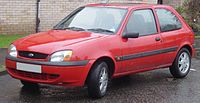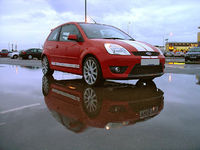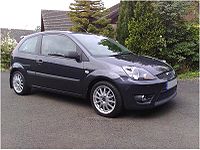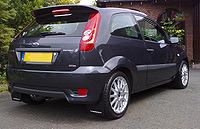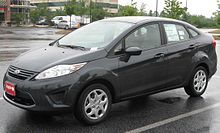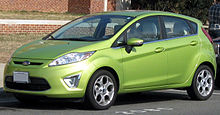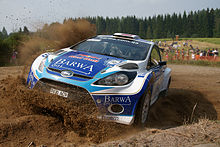- Ford Fiesta
-
Ford Fiesta 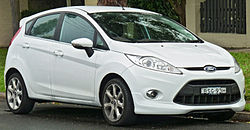
Manufacturer Ford Motor Company Production 1976–present Class Supermini, Subcompact Layout Front-engine, front-wheel drive Engine Inline-four The Ford Fiesta is a front wheel drive supermini/subcompact manufactured and marketed by Ford Motor Company and built in Europe, Brazil, Argentina, Mexico, Venezuela, China, India, Thailand and South Africa. The current-generation Fiesta is marketed worldwide.
By 2010, the sixth-generation (Mark VI)[1] Fiesta had been introduced worldwide, including in the United States and Canada—making it the first Fiesta model to be sold in North America since 1980.
The Fiesta has sold over twelve million units since 1976.[1]
History
The Fiesta was originally developed under the project name "Bobcat" and approved for development by Henry Ford II in September 1972. Development targets indicated a production cost US$100 less than the current Ford Escort.[2] The car was to have a wheelbase longer than that of the Fiat 127, but with overall length shorter than that of Ford's Escort. The final proposal was developed by Tom Tjaarda at Ghia. The project was approved for production in autumn 1973, with Ford's engineering centres in Cologne and Dunton (Essex) collaborating.
Ford estimated that 500,000 Fiestas a year would be produced, and built an all-new factory near Valencia, Spain; a transaxle factory near Bordeaux, France; factory extensions for the assembly plants in Dagenham, UK, and Saarlouis, Germany. Final assembly also took place in Valencia.[3]
Codenames
When Ford of Europe began to design the car, the design proposals were named Iris, Beta, The Deutschlander (from Ford's Cologne studios), Mini-Mite, and the Blue Car (from Ghia). Codenames for the Fiesta prototype included Torino, but it became Project Bobcat.
The shortlisted names for the new car designed by the project Bobcat team (headed by Mr Trevor Erskine) were Amigo, Bambi, Bebe, Bravo, Bolero, Cherie, Tempo, Chico, Fiesta, Forito, Metro, Pony and Sierra. Despite more board votes for "Bravo", Henry Ford II personally overruled them and named the car "Fiesta". Several of the shortlisted names were later used on other cars, including "Sierra", which was introduced on the Cortina replacement in 1982, and Tempo which was used on a Ford small car in the United States market. Ironically the "Metro" nameplate was introduced by rival manufacturer British Leyland for the similar-sized Austin Metro in 1980.
The name Fiesta belonged to General Motors at the time; however, it was freely given for Ford to use on their new B-class car. After years of speculation by the motoring press about Ford's new car, it was subject to a succession of carefully crafted press leaks from the end of 1975. A Fiesta was on display at the Le Mans 24 Hour Race in June 1976, and the car was launched and on sale in France and Germany in September 1976: to the frustration of UK dealerships righthand drive versions only began to appear in the UK in January 1977.[4]
Fiesta Mark I (1976–1983): The first generation
Ford Fiesta Mark I 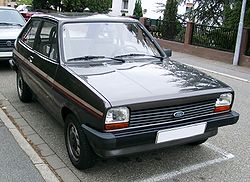
Production 1976–1983 Assembly Almussafes, Spain
Dagenham, United Kingdom
Cologne, Saarlouis, GermanyBody style 3-door hatchback
3-door panel vanEngine Petrol:
Kent/Valencia:
957 cc (58.4 cu in) 40–45 PS (29–33 kW),
1,117 cc (68.2 cu in) 53 PS (39 kW),
1,298 cc (79.2 cu in) 66 PS (49 kW),
1,597 cc (97.5 cu in) 84 PS (62 kW)Transmission Ford BC4 4-speed manual gearbox Wheelbase 2,286 mm (90.0 in) Length 3,565 mm (140.4 in) Width 1,567 mm (61.7 in) Height 1,360 mm (54 in) Mechanically, the Ford Fiesta followed tradition, with an end-on four-speed manual transmission mounted to a new version of the Ford Kent OHV engine, dubbed "Valencia" after the brand new Spanish factory in Almussafes, Valencia, developed especially to produce the new car. Ford's plants in Dagenham, England, and Saarlouis and Cologne (from 1979) in Germany, also manufactured Fiestas. To cut costs and speed up the research and development, many modified Kent engines destined for the Fiesta were tested in Fiat 127s – at the time considered the benchmark car in the class, with which the Fiesta shares styling similarities. This also allowed covert road testing across Europe.
Although not the first Ford vehicle to feature front wheel drive (the 1960s Taunus produced by Ford of Germany laid claim to that title), the Fiesta is widely credited as being Ford's first globally successful front wheel drive model. UK sales began in January 1977, where it was available from £1,856 for the basic 950 cc engined model.[5]
It was only the second hatchback mini-car to have been built in the UK at this stage, being launched a year after the Vauxhall Chevette, but a year before the Chrysler Sunbeam and four years before the Austin Metro. The millionth Fiesta was produced on 9 January 1979.
The car was available in Europe with a 957 cc (58.4 cu in) I4 (high compression and low compression options), either a 1.1 L and 1.3 L OHV petrol engines and in Base, Popular, L, GL (1978 onward), Ghia and S trim, as well as a van. The U.S. Mark I Fiesta was built in Cologne, Germany but to slightly different specifications; U.S. models were Base, Decor, Sport, and Ghia, the Ghia having the highest level of trim.[6] These trim levels changed very little in the Fiesta's three year run in the USA, from 1978–80. All U.S. models featured the more powerful 1.6 L (98 cu in) Kent inline-four engine (fitted with a catalytic converter and air pump for lower emissions), energy-absorbing bumpers, side-marker lamps, round sealed-beam headlamps, improved crash dynamics and fuel system integrity as well as optional air conditioning (a/c was not available in Europe). In the U.S. market, the Ford Escort replaced both the Fiesta and the compact Pinto in 1981.
A sporting derivative (1.3 L Supersport) was offered in Europe in 1980, effectively to test the market for the similar XR2 introduced one year later, which featured a 1.6 L version of the same engine. Black plastic trim was added to the exterior and interior. The small square headlights were replaced with larger circular ones resulting in the front indicators being moved into the bumper to accommodate the change. With a quoted performance of 0–60 mph (0–97 km/h) in 9.3 seconds and 105 mph (169 km/h) top speed, the XR2 hot hatch became a cult car beloved of boy racers throughout the 1980s.
Minor revisions appeared across the range in late 1981, with larger bumpers to meet crash worthiness regulations and other small improvements in a bid to maintain showroom appeal ahead of the forthcoming Mk 2.
In 1978, the Fiesta overtook the Vauxhall Chevette as Britain's best selling supermini, but in 1981 it was knocked off the top spot by British Leyland's Austin Metro and was still in second place at the end of 1982.
Mk I specifications Engine type(s) Inline-4: Petrol, Ford Kent/Valencia OHV Capacity 957–1,597 cc (58.4–97.5 cu in) Power 40–84 bhp (30–63 kW) Max. speed 85–106 mph (137–171 km/h) Acceleration 0–60 mph (97 km/h): 10.1–17.6 seconds Crayford convertibles
In 1982, coachbuilders Crayford produced the Fiesta "Fly"—a convertible version of the Mk 1 Fiesta 1300 Ghia, and a total of just fifteen vehicles were produced. The following year the more powerful 1600 Mk 1 Fiesta XR2 was the donor car, and a further seven convertibles were produced. The conversion involved welding the boot shut.
Fiesta Mark II (1983–1989): The second generation
Ford Fiesta Mark II 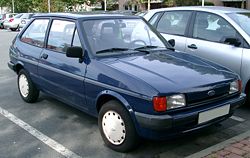
Production 1983–1989 Assembly Almussafes, Spain
Dagenham, United Kingdom
Cologne, Saarlouis, GermanyBody style 3-door hatchback
3-door panel vanEngine Petrol:
Kent/Valencia:
957 cc (58.4 cu in) 45 PS (33 kW),
1,117 cc (68.2 cu in) 49–53 PS (36–39 kW),
1,298 cc (79.2 cu in) 66 PS (49 kW);
CVH:
1,298 cc (79.2 cu in) 69 PS (51 kW),
1,368 cc (83.5 cu in) 71 PS (52 kW),
1,597 cc (97.5 cu in) 96 PS (71 kW);
Diesel:
1,608 cc (98.1 cu in) 54 PS (40 kW)Transmission Ford BC4 & BC5 4- or 5-speed manual gearbox,
continuously variable transmissionWheelbase 2,286 mm (90.0 in) Length 3,565 mm (140.4 in) Width 1,567 mm (61.7 in) Height 1,360 mm (54 in) The Fiesta Mark II appeared towards the end of summer 1983 with a revised front end and interior, and a bootlid mirroring the swage lines from the sides of the car. The 1.3 L OHV engine was dropped, being replaced in 1984 by a CVH powerplant of similar capacity, itself superseded by the lean burn 1.4 L two years later. 957 and 1117 cc engines continued with only slight alterations and for the first time a Fiesta diesel was produced with a 1600 cc engine adapted from the Escort.
The new CTX continuously variable transmission, also fitted in the Fiat Uno, eventually appeared early in 1987 on 1.1 L models only. This gearbox provided a quick and economic driving experience, despite the resemblance of the sensation of the continuously variable transmission to that of a slipping clutch.
The Mk 2 featured a different dashboard on the lower-series trim levels compared to the more expensive variants.
The XR2 model was thoroughly updated with a larger bodykit. It also featured a 96 bhp (72 kW) 1.6 L CVH engine as previously seen in the Ford Escort XR3, and five-speed gearbox (also standard on the 1.3 L CVH models). The engine was replaced by a lean-burn variant in 1986 which featured a revised cylinder head and carburettor; it was significantly cleaner from an environmental viewpoint but was slightly less powerful as a result (95 bhp (71 kW)). A truly "hot" Fiesta was never produced by the factory to avoid impacting on sales of performance Ford Escort variants but many aftermarket conversions were available, the best-known being that by the English firm Turbo Technics boosting power to a well documented 125 bhp (93 kW), which easily outclassed its "standard" rivals. Ford appreciated the high quality of this conversion and was keen to look after its customers: the installation was undertaken by approved fitting centres and all the warranties remained valid after.
The face-lifted, facing competition from the Vauxhall Nova and Austin Metro, was one of the UK's top supermini. In its best-ever year, 1987, over 150,000 Fiesta models were sold in the UK,[2] though it missed out on first place in the sales charts to the Ford Escort.
The Mk 2 Fiesta lives on as the donor vehicle for Quantum Sports Cars' 2+2 convertible[7] with several hundred manufactured at the factory in Stourbridge before production moved to Kingsbridge.
- Mk II specifications
Engine type(s) Inline-4: Petrol, Ford Kent/ValenciaOHV, Ford CVH, and Diesel Capacity 957–1,608 cc (58.4–98.1 cu in) Power 45–96 bhp (34–72 kW) Max. speed 88–101 mph (142–163 km/h) Acceleration 0–60 mph (97 km/h) 8.7–19.0 seconds Fiesta Mark III (1989–1997): The third generation
Ford Fiesta Mark III 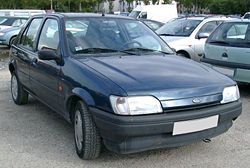
Production 1989–1997 Assembly Almussafes, Spain
Dagenham, United Kingdom
Cologne, Saarlouis, GermanyBody style 3-door hatchback
5-door hatchback
3-door panel van
3-door 'high cube' panel vanPlatform Ford B platform Engine Petrol:
1,753 cc (107.0 cu in) 60 PS (44 kW)
Kent/HCS:
999 cc (61.0 cu in) 45 PS (33 kW),
1,118 cc (68.2 cu in) 50–55 PS (37–40 kW),
1,289 cc (78.7 cu in) 60 PS (44 kW);
CVH:
1,392 cc (84.9 cu in) 71–75 PS (52–55 kW),
1,596 cc (97.4 cu in) 104 PS (76 kW),
1,596 cc (97.4 cu in) Turbo 133 PS (98 kW);
Zetec:
1,598 cc (97.5 cu in) 90 PS (66 kW),
1,796 cc (109.6 cu in) 105–130 PS (77–96 kW);
Diesel:Transmission Ford IB4 & IB5 4- or 5-speed manual gearbox,
continuously variable transmissionRelated Ford Ka
Ford CourierThe third generation Fiesta Mark III, codenamed BE-13 was unveiled at the end of 1988 and officially went on sale in the February of the following year. Although it was essentially a reskin of the Mk.II (which in turn was a facelift of the 1976 original), it looked radically different, and did address the principal weakness of the previous generation – the lack of a 5-door derivative, something that was by then available in its major rivals such as the Fiat Uno, Peugeot 205 and Opel Corsa. The other main change was to the running gear – the improved HCS (High Compression Swirl) version of the Kent/Valencia powerplant. The CVH units from the Mk II were carried over largely unmodified. The diesel engine was enlarged to a 1.8L capacity.
This model had the longest production life of any Fiesta to date, achieved the highest yearly sales of any Fiesta in the early 1990s – achieving a sales volume of 1 million units inside the first two years of production, and underwent numerous changes in its life. For example, the car had four different versions of standard steering wheels during its lifetime (the launch wheel, then updated in 1992, 1994 and 1995) and the most changes to standard UK trim levels of any Fiesta (examples across the years show the large line-up: Popular, Popular Plus, L, LX, Ghia, 1.6S, XR2i, RS Turbo, RS1800, Fiesta, Louisiana, DL, SX, Azura, Si, Classic, Classic Quartz, Classic Cabaret, Saphire). A Fiesta-derived van, the Ford Courier, was launched in 1991.
Fuel injection engines became available in 1991. Major changes were introduced to the range in 1994. Major structural improvements were made to improve safety, as well as a new immobiliser being fitted to petrol models. The UK trim line-up was also simplified to Fiesta, LX, Si (which also had a new bumper and seat designs) and Ghia. Revised door mirrors were also fitted, as were a line-up of fresh wheel trim designs.
As for sports models, the XR2i was launched in 1989[1] with an 8v CVH (compound valve-angle hemispherical combustion chamber) engine but was replaced by a Zetec 16v version in 1992, which also saw the RS Turbo being supplanted by the RS1800—as the CVH engine was being phased out, the RS1800 shared its 1.8 L Zetec fuel-injected engine with the 130 PS (96 kW; 130 bhp) version of the then-current Ford Escort XR3i and had a top speed of 125 mph (201 km/h). The XR2i name was also dropped in early 1994, and the insurance-friendly "Si" badge appeared in its place on a slightly less sporty-looking model with either the 1.4 L PTE (a development of the CVH) or the 1.6 L Zetec engine.
From 1995 the vehicle was built and sold at the same time as the new Mark IV. To distinguish the car, trim levels were revised, and it was marketed as the "Fiesta Classic". This continued until production finally ceased in 1997.
- Mk III specifications;
Engine type(s) Inline-4: Petrol, Ford Kent/HCS (OHV), Ford CVH (OHC), Ford Zetec (OHC), and Diesel (OHC) Capacity 999–1,796 cc (61.0–109.6 cu in) Power 45–133 bhp (34–99 kW) Max. speed 86–129 mph (138–208 km/h) Acceleration 0–60 mph (97 km/h) 7.9–19.0 seconds Fiesta Mark IV (1995–2002): The fourth generation
Ford Fiesta Mark IV 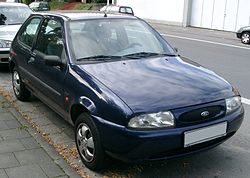
Also called Mazda 121
Mazda SohoProduction 1995–2002 Assembly Almussafes, Spain
Dagenham, United Kingdom
Cologne, Saarlouis, Germany
São Bernardo do Campo, Brazil
Port Elizabeth, South AfricaBody style 3-door hatchback
5-door hatchback
3-door panel van
3-door 'high cube'panel vanPlatform Ford B platform Engine Petrol:
1,753 cc (107.0 cu in) 75 PS (55 kW)
Kent/Endura-E:
1,299 cc (79.3 cu in) 50–60 PS (37–44 kW);
Zetec-SE:
1,242 cc (75.8 cu in) 75 PS (55 kW),
1,388 cc (84.7 cu in) 90 PS (66 kW);
Diesel:
1,753 cc (107.0 cu in) 60 PS (44 kW);
Endura-D:Transmission Ford IB5 5-speed manual gearbox,
continuously variable transmissionRelated Ford Ka
Ford Puma
Ford IkonThe all new Fiesta Mark IV (internal code name was BE91) was launched in 1995[1] and became Britain's best selling car from 1996–1998.
The model used the chassis of the Mk 3 car[citation needed], but most components were heavily revised, including a new suspension system, which gave the Fiesta one of the best handling abilities in its class.
The model featured a range of new Zetec engines, available in 1.25 L and 1.4 L forms, the 1.8 diesel engine was slightly modified for the Mk 4, now marketed as the "Endura DE". The 1.3 L OHV engine was carried over from the Mk 3. As well as the major changes to the chassis, the Mk 4 also benefited from a new interior and exterior styling, including a soft painted instrument panel for the first year of production, albeit maintaining a similar dimensions to the Mk 3. The RS1800 and RS Turbo models were not carried over to the updated Fiesta range.
The Mk 4 Fiesta shared a production line and design with the Mazda 121, which sold in much lower volumes and was not produced for the British market after 1999.
In Brazil a 1.0-litre version was available, in L, LX and GL trim levels; it was sold in Argentina and Chile. The UK trim level line up had relatively few changes over the years: (1995, Encore, LX, Si, Ghia; 1996, Ghia X added as range-topper; 1998, Si replaced by Zetec, petrol LX models briefly renamed Zetec LX, Ghia X models axed; 1999, Finesse added between Encore and Zetec).
In 1997, the Mk 4 was introduced into South Africa. This is the first time the Fiesta entered the South African vehicle market. Only one engine was available, the 1.3 L Endura E. It subsequently won the South African Car of the Year award. The 1.3 L engine was replaced with the 1.4 L PTE (CVH) engine in 1999.
The Mk 4 was not sold in North America.
The German-built Ford Puma was based on the Mk 4, sharing its underpinnings. For this reason the 1.7 VCT engine from the Ford Puma has become an extremely popular engine swap into the Mk 4 and the Mk 5 Fiesta. This gives the popular hatchback an extra 100 cc over the previous largest engine size available, variable cam timing and better ratio gearbox while still retaining a factory finish as all components are a direct swap.
As an exercise in badge engineering, the Mazda 121 and Ford Fiesta were built on the same production lines and used almost all the same parts. In the JD Power reliability surveys at the time, the Mazda was reported to be significantly more reliable and attracted higher levels of customer satisfaction.
- Mk IV specifications
Engine type(s) Inline-4: Petrol, Ford Kent/Endura-E (OHV), Zetec-SE (OHC), and Diesel (OHC) Capacity Petrol: 1,242–1,596 cc (75.8–97.4 cu in) Diesel: 1,753 cc (107.0 cu in) Power 59–91 bhp (44–68 kW) Max. speed 96–112 mph (154–180 km/h) Acceleration 0-62 mph (100 km/h) -
1.25: 11.9 s
1.4: 10.8 s
1.8D: 14.7 s
1.8D: 16.2 s
1.4 Zetec: 9.6 sFuel efficiency 38–46 mpg-UK (32–38 mpg-US or 7.4–6.1 L/100 km) Fiesta Mark IV (1999–2002): facelift
In 1999, the Fiesta received a minor facelift[6][8] aimed at giving the car a New Edge look, with a Focus-inspired face, new bumpers and wheel designs. Facelift known as Mark V in United Kingdom and elsewhere.
Other changes include 1.6i 16V Zetec engine, fitted to the new Zetec S model, and later available in Ghia and Freestyle trims. New features such as side airbags and (after launch) the reintroduction of leather trim. An environmentally-friendly E-Diesel model for 2001, with CO2 emissions of 120 g/km. The Lynx 1.8 TDDi engine (also introduced after launch).
The Mk IV facelift[8] was the last generation of Fiesta to be built at Dagenham in England. Its internal code name was still BE91. The UK trim level line-up consisted of: 1999, Encore, Finesse, Zetec, LX, Ghia; 2000, Zetec S added; 2001, E-Diesel added at bottom of range, Flight and Freestyle respectively replace Finesse and Zetec.
In South Africa, the facelift used the Port Elizabeth-built 1.3 L and 1.6 L Rocam engines, instead of the European Sigma 16-valve engines. This model formed the basis of the Ford Ikon (code name C195), which is a four-door sedan designed for India, where Ford was now producing cars in a joint venture with Mahindra.[citation needed] The Ikon was also introduced in other developing countries, such as Brazil (where it is known as the Fiesta Sedan), South Africa, Mexico and China, where sedans are preferred to hatchbacks. They are extremely reliable, and became one of Ford's successes. There were also four truck variants, the simplest being the "Fiesta Van" which was a three-door hatchback with the rear quarter windows blanked over and the rear seat omitted. Another van with a boxy rear body and stretched wheelbase used the Courier nameplate and formed the basis of two pick-up models, one with the short doors of the 5-door hatchback and small quarterlights in the style of larger extended cab pick-ups, made in South Africa; and another with the 3-door's longer doors and no quarter windows, made in Brazil.
The Fiesta was still Britain's best-selling supermini in 2001, by which time it was making use of a design over a decade old (though heavily updated visually and mechanically). In three-door form, it was sold alongside the Mk 5 Fiesta from April to December 2002.
The Zetec S
The Zetec S was the highest Fiesta trim, and although its 1.6 L 16v Sigma engine was available in other Fiestas (such as the Freestyle) the Zetec S pushed out 101 bhp (75 kW; 102 PS),[9] and had major alterations to the suspension, with stiffer anti-roll bars and uprated brakes shared with the Puma.
The Zetec S Mk 5 facelift[8] has a sizeable following, with many websites dedicated to the vehicle. There is also a tuning culture devoted to this model, with reputable companies such as Milltek Sport and Shawspeed developing performance parts solely for the Sigma engine.
Mk IV facelift specifications
Engine type(s) Inline-4: Petrol, Ford Kent/Endura-E (OHV), Zetec-SE (OHC), and Diesel (OHC) Capacity Petrol: 1,242–1,596 cc (75.8–97.4 cu in) Diesel: 1,753 cc (107.0 cu in) Power 59–102 bhp (44–76 kW) Max. speed 95–113 mph (153–182 km/h) Acceleration 0–60 mph (97 km/h) 9.9–16.9 seconds Fuel efficiency 38–53 mpg-UK (32–52 mpg-US or 7.4–4.6 L/100 km) Fiesta Mark V (2002–2008):The fifth generation
Ford Fiesta Mark V 
Production 2002–2008 (Brazil 2002 on) Assembly Almussafes, Spain
Cologne, Saarlouis, Germany
Camaçari, Brazil
Valencia, Venezuela
Chennai, IndiaBody style 3-door hatchback
5-door hatchback
3-door panel van
4-door sedanPlatform Ford B3 platform Engine Petrol:
1,560 cc (95 cu in) TDCi 90 PS (66 kW) (2005 on)
Duratec:
1,299 cc (79.3 cu in) 60 PS (44 kW);
Zetec-SE:
1,242 cc (75.8 cu in) 75 PS (55 kW),
1,398 cc (85.3 cu in) 80 PS (59 kW),
1,596 cc (97.4 cu in) 100 PS (74 kW);
Duratec 20:
1,998 cc (121.9 cu in) 150 PS (110 kW);
Diesel:
Duratorq DLD-414
1,398 cc (85.3 cu in) TDCi 68 PS (50 kW);
Duratorq DLD-416Transmission Ford IB5 5-speed manual gearbox,
4-speed automatic transmissionWheelbase 2,486 mm (97.9 in)
Brazil: 2,488 mm (98.0 in)Length 3,918–3,924 mm (154.3–154.5 in)
Brazil Hatchback: 3,930 mm (155 in)
Brazil Sedan: 4,221 mm (166.2 in)
Trail: 4,030 mm (159 in)Width 1,685 mm (66.3 in) Height 1,464–1,468 mm (57.6–57.8 in)
Brazil Hatchback: 1,451 mm (57.1 in)
Trail: 1,550 mm (61 in)Curb weight 1,096–1,178 kg (2,420–2,600 lb) Related Ford Fusion
Ford Ecosport
Ford Figo
Mazda2On 1 April 2002, the all new five-generation car was unveiled. Of this Fiesta Mark V, most engines were carried over from the previous Fiesta, but renamed "Duratec", as the "Zetec" name was now solely used for sportier models. The previous push-rod 1.3 L engine was initially available in the UK, but this was quickly replaced with a Rocam 1.3 L, both under the name Duratec 8v.[10] Trim levels available initially were Finesse, LX, Zetec and Ghia, with limited edition variants soon following. The Mk 5 was also the first Fiesta to feature the Anti-lock Braking System and passenger airbags as standard. The fifth generation was known as Mark VI in United Kingdom and elsewhere. This generation became the best selling Ford Fiesta generation to date.
Engines available include 1.25 L, 1.3 L, 1.4 L, 1.6 L, 2.0 L petrol, plus 1.4 L 8v and 1.6 L 16v Duratorq TDCi common-rail diesels built in a joint venture with PSA.
This was also the first Fiesta to be sold in Asia and Australasia (all 1.6 L LX 3dr/5dr, Zetec 3dr, Ghia 5dr), replacing the Kia-based Festiva. In Brazil and Argentina, a Fiesta sedan version was introduced in late 2004. A similar Fiesta sedan model, with a different front end, was released in India in late 2005. This Fiesta generation was ergonomically and mechanically more advanced than any previous generation. The 2005 facelift came with an even improved exterior.
Fiesta South America
In Brazil, the engine options also include 1.0 L 8v Flex and 1.6 L 8v Flex engines called Rocam, that runs on ethanol, petrol or any mixture of both. The internal codename of this model is B256 (5-door) and B257 (3-door). In other Mercosur countries the Fiesta features a 1.6 L 98 bhp (73 kW) SOHC Zetec engine has a standard with the choice of either a 4-speed automatic or 5-speed manual transmission. There is also a 1.4 L 68 bhp (51 kW) diesel engine available. For the Colombian market a 1.0 L 8v Rocam engine was sold with a supercharger, producing 96 bhp (72 kW). This was discontinued on 2009 and replaced by the Mark VI imported from Mexico.
The South American market Fiesta was facelifted in early 2007 as a 2008 model, with new rectangular headlights and grille. And again, in early 2010 the Fiesta was facelifted as a 2011 model, with new headlights and grille, very similar to those on the mark VI Fiesta available in other markets around the world, but keeping all other features nearly the same as the previous model. Its name varies from country to country, called "Fiesta One" in Argentina, "Fiesta Move" in Venezuela, and "Fiesta Rocam" in Brazil.[11][12][13]
Fiesta in India
In the Indian market Ford produced the Ford Ikon and Fiesta Mk V in parallel for the sedan market until April 2011. Production of the Ford Ikon was discontinued when the Bharat IV emission requirements came into effect for metropolitan areas.[14] Ford then announced its intent to launch the Fiesta Mark VI at a lower price and new features, including dual airbags, bringing the Fiesta in line with competitors such as the Honda City, Suzuki SX4, Volkswagen Vento and Hyundai Verna.[15] In July, Ford replaced the Mk V with the Fiesta Mk VI, marketed in India as the Ford Fiesta 2011[16]
Fiesta ST/XR4
The Fiesta ST/XR4 was the performance model of this Fiesta. It includes a 2.0 L Duratec petrol engine rated at 150 PS (110 kW; 150 bhp) in standard form, with a top speed of 129 mph (208 km/h).[17] The Fiesta ST also features 17 in (43 cm) alloy wheels, different front and rear bumpers, side skirts, body colour handles and bump strips, partial leather seats and a ST logo on the steering wheel.
In Australia, the Fiesta ST was sold as the Fiesta XR4. To stay in line with all sports model Fords sold in Australia it received the 'XR' badging, instead of the 'ST' badging used in Europe.
The vehicle was unveiled at the 2004 Geneva Motor Show.[18]
Fiesta RallyeConcept
This is a British 3-door concept car designed by Ford RallyeSport and Ford Design Europe, designed for the Super 1600 rally. The 1.6 L Duratec engine was rated 200 bhp (150 kW; 200 PS). It includes four-two-one Arvin Meritor exhaust, 6-speed Hewland sequential gearbox, MacPherson strut front and twist-beam rear suspensions, 15-spoke magnesium wheels with 18" Pirelli P-Zero tyres.
The car was unveiled at the Birmingham Auto Show.[19]
Fiesta RS concept
This is a concept model based on the 2002 Fiesta RallyeConcept. It includes many of the RallyeConcept Fiesta features such as the cooling vents in the front bumper, deep side rockers, white ceramic-coated brake calipers and exhaust tips, and a large rear spoiler. It also includes 18-inch alloy wheels with low-profile tyres, extended wheel arches, and lowered and stiffened suspension. The engine is rated at over 180 bhp (130 kW).[20]
Fiesta Mark V (2005–2008): facelift
In November 2005, a revised version of the Mk 5 Fiesta went on sale, also known as the Mk 5 facelift. A number of cosmetic changes were introduced: front and rear lights featured new detailing, and bumpers, side mouldings and door mirrors were altered. A bright new colour palette was introduced. The facelift is known as the Mk 6.5 in the UK, or Mark 7 elsewhere (mistakenly)[citation needed], as this was simply a revised version of the Mark VI and not a completely new car.
Inside, the dashboard was redesigned with better quality soft touch materials, following criticisms of the hard, cheaply textured original. A new analogue instrument display is included in a style similar to the Mk 2 Ford Focus. The facelift also includes new technology, including power folding mirrors, automatic and 'home-safe' headlights, automatic windscreen wipers, Bluetooth with voice control, Trip computer, MP3 player connectivity and the Electronic Stability Program.
The changes had immediate effects on sales. After years being outsold by Vauxhall's Corsa, among others, in February 2006 Ford announced sales in the preceding month were up 25% on January 2005 for the previous model. Furthermore, the Fiesta captured the title of Britain's most popular supermini in both 2006 and 2007, for the first time since 2001.[21]
In the UK, the car is available in Studio, Style, Style Climate, Zetec, Zetec Climate, Zetec S, ST and Ghia trim levels with what was called a 'Tech Pack' available to all trim levels above the Style Climate, this featured the power folding mirrors, automatic wipers, automatic and home safe lights and an advanced trip computer.
In 2007, more limited editions were added—the Fiesta Zetec Blue, and (following on from the hugely successful Fiesta Zetec S "Anniversary" edition), the Fiesta Zetec S 'Celebration'. In 2008, the Fiesta Zetec S Red was added, as well as an ST500 model.
Limited editions
The Zetec S "Anniversary" was a limited edition of 400 cars based on the Zetec S and included a Radian Yellow body, chequered roof, black mirrors and door handles, tinted glass, 16 in (41 cm) alloy wheels, black roof spoiler, sports seats, leather trim, an alarm, and an iPod socket.[22]
The car went on sale in the UK on March 2007 for £12,595. Despite the name, the Ford Fiesta was 31 years old when the anniversary model was released.[23]
The Zetec S "Celebration" was a limited (400 cars) edition based on the Zetec S and included a Celebration Green body, black and white chequered roof decal, unique identity number, chequered scuff plates and mats, full 'Ebony Haze' leather interior, privacy glass and Panther Black door mirrors, bodyside mouldings, roof spoiler, tailgate handle, 16 in (41 cm) alloy wheels, air conditioning, trip computer, electric windows, CD player with portable music connection socket, sports front seats and lowered sports suspension.
The car went on sale in the UK for £12,595.[24]
The Zetec S Red was a limited (500 cars) edition based on the Zetec S and included a Colorado Red body, black and white chequered roof decal, dark privacy glass on the rear windows, panther black door mirrors, door handles, bodyside mouldings, roof spoiler and tailgate handle; Quickclear heated front windscreen, ebony leather seats, 16 in (41 cm) alloy wheels, air conditioning and heated electrically-operated door mirrors.
The car went on sale in the UK for £13,000.[25]
Fiesta ST
In 2008, Ford offered Mountune Performance options for Fiesta ST vehicles, available at specialist British Ford dealers beginning in March 2008. These were developed by Roush Technologies Ltd, which owns the Mountune Racing motorsport brand. The Mountune Performance Stage 1 (£1,435) includes a high flow catalyst and tubular manifold, and re-calibration of the engine to produce 165 PS (121 kW; 163 bhp). The Mountune Performance Stage 2 package (£1,838) adds new camshafts and valve springs to the basic package to deliver 185 PS (136 kW; 182 bhp).[26]
The ST 500 was a limited production (500 vehicles) model of the Fiesta ST. It includes 17 in (43 cm) 11-spoke black alloy wheels, red brake callipers and carbon fibre pattern interior trim. The interior also features a Sony audio system and ebony leather heated seats. The vehicle cost £15,000.[27]
Mk V specifications
Engine type(s) Inline-4: Petrol, Duratec (OHV), Zetec-SE and Duratec 20 (OHC), and Diesel, Duratorq DLD-414 and Duratorq DLD-416 (OHC) Capacity 1,242–1,998 cc (75.8–121.9 cu in) Power 60–150 bhp (45–110 kW) Max. speed 94–130 mph (151–210 km/h) Acceleration 0–60 mph (97 km/h) 7.9–18.8 seconds Sales figures
In 2002, it was the fifth best selling new car in the UK, but was ranked third in the supermini charts after the Vauxhall Corsa and Peugeot 206. It claimed the top spot in its sector in 2006.[citation needed]
The Fiesta is one of Brazil's best-selling vehicles, selling around 5,000 units per month. From September 2002 to April 2007, more than 336,000 units have been sold, outselling its competitors: Chevrolet Corsa (183,000 in the same period) and Renault Clio (122,267). Ford Brazil also makes a Fiesta Sedan, which has sold 113,000 units since its launch in 2004.[citation needed]
Marketing
Since the launch of the 2005+ model, the advertising motto has been "StupidDogbot, CleverFiesta", with the car showing a new gadget, while the robotic dog does something stupid; e.g., the Fiesta showing MP3 connectivity, while the Dogbot sticks its head into an old record player.
The September 2008 advert for the UK-spec Fiesta used Transient by Pluxus as backing track.
Fiesta Mark VI (2008 on):The sixth generation
Ford Fiesta Mark VI 
Manufacturer Ford Motor Company Production 2008 on Assembly Almussafes, Spain
Nanjing, China
Cologne, Germany
Cuautitlán Izcalli, Mexico
Rayong, Thailand (2010 on)
Valencia, Spain
Chennai, India[16]Body style 3-door Hatchback
5-door Hatchback
4-door sedan
2-door VanPlatform Ford global B-car platform Engine 1.4 L I4
1.6 L I4
1.25 L I4
1.4 L Diesel I4
1.6 L Diesel I4Transmission 4-speed automatic
5-speed manual
6-speed PowerShiftWheelbase 2,489 mm (98.0 in)
Van: 2,487 mm (97.9 in)Length Sedan: 173.6 in (4,409 mm)
2011 on Hatchback: 160.1 in (4,067 mm)
2008–2010: 3,950 mm (156 in)
Van: 3,917 mm (154.2 in)Width 1,722 mm (67.8 in)
Van: 1,683 mm (66.3 in)Height 2011 on: 58.0 in (1,473 mm)
2008–2010: 1,481 mm (58.3 in)
Van: 1,467 mm (57.8 in)Curb weight 1,041–1,092 kg (Petrol), 1,086–1,100 kg (Diesel) Related Mazda2 The sixth generation, or Ford Fiesta Mark VI,[28] was shown in concept form as the Ford Verve at the Frankfurt Motor Show in September 2007 and marketed in principal European markets,[29] Australia and the United States. This model is based on Ford's new global B-car platform. The sixth generation is known as Mark VII in the United Kingdom.[30] Production started at Ford's Cologne plant in Germany in August 2008. A second plant in Valencia, Spain started production in early 2009. Productions in China, Thailand and Mexico started from late 2008 to 2010.[31]
Fiesta sales for Canada began in June 2010 for model year 2011.[32] The 5-door hatchback will also be sold in Mexico starting 2011.[33]
The sixth generation sedan was launched in India in July 2011 with both petrol and diesel variants.[16][34]
Equipment
The 2008 Fiesta includes Ford's Convers+ menu system, as seen on the Mondeo, S-MAX and Galaxy, and complemented by steering wheel button controls. Ford initially anticipated that over 85% of Fiesta orders would include this multifunction display. Other new equipment includes keyless entry with a 'Ford Power' starter button, reach and rake adjustable steering wheel, electric power steering, and a USB port for portable music players. Ford Easyfuel, the capless refuelling system recently introduced with the Ford Mondeo, will also be a feature, while 'ambient lighting,' casting a soft red glow over the interior, will be an option. For the 2011 US market model, the Ford Sync in-car communications and entertainment system will be available as an option.
UK trim levels for the new Fiesta include Studio, Edge, ECONetic, Zetec, Zetec S, Titanium and Titanium Individual.
ECOnetic model
Main article: ECOneticIn 2008 Ford revealed details of an ECOnetic model, which Ford stated would emit 98g/km of carbon dioxide. The car was launched in 2009. It uses the 1.6 Duratorq TDCi diesel engine, but with an added diesel particulate filter. The Fiesta ECOnetic achieves its environmental credentials through weight loss and aerodynamic adjustments, and its emission figure exempts the car from UK vehicle excise duty. The ECOnetic gets an estimated fuel consumption of 65 mpg-US (3.6 L/100 km; 78 mpg-imp).[35] When tested on the highway mileage and emissions test schedules, on which hybrids are designed to perform well,[36] the ECOnetic outperforms the Toyota Prius.[37] The model will not be available in the U.S. because, as Business Week noted, the company "doesn't believe it could charge enough to make money on an imported ECOnetic" and doesn't think it would sell enough of the model (350,000/year) to justify the $350 million in upgrades required at their Mexico plant to manufacture it in North America.[35]
Fiesta ST
In 2011 Ford revealed the Fiesta ST concept based on the Fiesta mk7[38]. The High Performance Fiesta is powered by a 1.6-litre Ford Ecoboost Engine to deliver performance while still providing good fuel efficiency. The 1.6-litre Ford Ecoboost Turbocharged engine will feature Twin-independent Variable Camshaft Timing (Ti-VCT) and put out 180 PS (130 kW; 180 bhp) with 240 N·m (180 lb·ft) of torque providing an acceleration time of under 7 seconds (0–100 km/h) and a top speed exceeding 220 km/h. Mated to a 6-speed manual transmission, the car is expected to provide responsible fuel economy while not sacrificing performance. The concept ST features a redesigned front fascia similar to the one seen on its older sibling (Focus ST), LED-laced headlights, Large rear spoiler, aggressive rear diffuser with a twin exit exhaust system, completed with 17-inch wheels. On the inside, the ST provides heavily bolstered Recaro front seats and sportier décor.
The Fiesta ST Production model is expected to come out in Europe sometime next year, but may also come to the North American market as a five-door hatchback variant instead of the three-door Europe is offered with.
Body styles
There are 4 body styles, including 3 and 5-door hatchbacks, 4-door sedan, and 2-door van. They are sold separately depending on the country.
- 5-door hatchback
- Sold globally except India.
- 4-door sedan
- Originally available in Chinese and American market, later in other parts of Asia, and then in Australasia.
- 3-door hatchback
- Sold in Europe, Australasia, and small parts of Asia such as Singapore.
- 2-door van
- Sold only in Europe. Uses the same bodyshell as the 3-door, modified with solid panels in place of the rear quarter windows and a flat load floor replacing the rear seat.
Powertrain
Model Years Type Power, torque@rpm Petrol engines[39] 1.25 L Duratec 60 PS From 2008 1,242 cc (75.8 cu in) I4 60 PS (44 kW; 59 bhp), 109 N·m (80 lb·ft) 1.25 L Duratec 82 PS From 2008 1,242 cc (75.8 cu in) I4 82 PS (60 kW; 81 bhp), 114 N·m (84 lb·ft) 1.4 L Duratec From 2008 1,388 cc (84.7 cu in) I4 96 PS (71 kW; 95 bhp), 128 N·m (94 lb·ft) 1.6 L Duratec Ti-VCT From 2008 1,596 cc (97.4 cu in) I4 120 PS (88 kW; 120 bhp) @ 6,000 rpm, 152 N·m (112 lb·ft) @ 4,050 rpm Diesel engines 1.4 L Duratorq TDCi From 2008 1,398 cc (85.3 cu in) I4 68 PS (50 kW; 67 bhp) @ 4,500 rpm, 160 N·m (120 lb·ft) @ 2,000 rpm 1.6 L Duratorq TDCi From 2008 1,560 cc (95 cu in) I4 75 PS (55 kW; 74 bhp), 185 N·m (136 lb·ft) 1.6 L Duratorq TDCi From 2008 1,560 cc (95 cu in) I4 90 PS (66 kW; 89 bhp), 212 N·m (156 lb·ft) 1.6 L Duratorq TDCi ECOnetic From 2008 1,560 cc (95 cu in) I4 90 PS (66 kW; 89 bhp), 200 N·m (150 lb·ft) The 1.6 L Duratorq TDCi with 75 PS (55 kW; 74 bhp) is sold instead of, in some countries alongside with the 1.4 L TDCi.
The 1.6 Duratorq TDCi with 212 N·m (156 lb·ft) torque is used on non-van models only. Vans with the 1.6 Duratorq TDCi are rated 200 N·m (150 lb·ft) torque.
Transmission choices include a 5-speed manual or 4-speed automatic. The automatic is only offered with the 1.4 L Duratec. The 2011 North American model offers the Powershift 6-speed dual-clutch as an option in addition to the 5-speed manual, which may be sold with a diesel in Europe in the future.
Thailand is the last plant to start assembling Ford Fiesta for ASEAN countries.[40] However 6-speed 'Powershift' dual clutch transmission will be available as standard transmission for 1.6L Ti-VCT engines in Thailand[41]. Curiously, the Thai-made Fiesta versions – both sedan and five-door hatch – feature a 100 mm pitch circle diameter (PCD) wheel lug mount measurement identical to the Mazda2, as opposed to the 108 mm one as found in other global versions.
In Brazil, the Mexican Fiesta is sold only in 4-door version. The Brazilian-made Sigma 1.6-liter engine is flex fuel, but it does not use variable valve timing. The power output and torque are 110 bhp (82 kW) and 155 N·m (114 lb·ft) with petrol and 115 bhp (86 kW) and 159 N·m (117 lb·ft) with ethanol.
Reception
In late 2008 Motor Trend called the new generation of Fiesta a "superb little car" whose "greatest problem is that it's still a year away",[42] a reference to the fact that the Fiesta would not arrive in the USA until early 2010. British magazine Auto Express called the car a "new class leader";[43] UK's Car Magazine said it was a "huge achievement" which will "please just about everyone".[44] The February 2009 issue of Britain's What Car? magazine named the new Fiesta "Car of the Year" and the Ford Mondeo "Best Family Car" and "Best Estate."[45] According to What Car?, there is plenty of space in the front of the cabin, however, the rear knee space is rather limited and the backrests do not fold flat onto the base, making an uneven floor for the expanded boot.[46] This generation draws some criticism for its similarity to Peugeots, especially the design of the front end and the headlights. Unlike previous generations, which were more or less gender-neutral, this generation is said to be more appealing to females than males.[who?]
The Fiesta was featured on episode 6 of series 12 of Top Gear in a series of "serious" road tests conducted by presenter Jeremy Clarkson, from escaping 'baddies' driving a Chevrolet Corvette C6 in the Festival Place Basingstoke shopping mall, to participating in an amphibious beach assault with the Royal Marines.
In its first two years since the latest generation Fiesta went on sale in October 2008, more than 940,000 Fiestas had been purchased by customers around the world, with 810,000 (86%) being sold in Europe (September, 2010).[47]
North American market
Kevin George directed the adaptation of the Fiesta's design for the North American market, reshaping the front end to comply with federal impact standards, keeping the styling substantially like the European model. "I spent about two years trying to make it look like I did nothing", George said.[48] The North American front fascia includes LED parking lamps, used in a few other markets.[48]
Unveiled at the 2009 Los Angeles Auto Show in December,[49] the Fiesta offers Ford's "Powershift" dual-clutch automatic transmission and is offered as a four door sedan and five door hatchback.
Ford dealers in the US will offer optional laminated vinyl graphics applied to the car's exterior, expected to last 3 to 5 years before being replaced.[50] Also, certain dealers partaking in a new Ford Retail program will provide an "unwrapping" digital package loaded with a photograph of the buyer taking delivery of his/her new car. A 19-minute audio description of the car and its features is included, which can be played on the way home, then loaded along with its interactive program into the home computer via its USB connection.[51]
Preliminary marketing
For the North American Fiesta, Ford initiated a marketing campaign in the spring of 2009 called the Fiesta Movement, distributing examples of European Fiestas to applicants across the United States—to have the test drivers use popular Internet sites to share their experiences.[52] Subsequently, Ford brought the cars to public venues nationwide to offer 100,000 test drives over eight months.[53] One such event was offering free shuttle service in Chicago from a site near the Union Station commuter rail terminal to the Taste of Chicago event in Grant Park the week starting 29 June 2009. Late in July, six European Fiestas arrived in Halifax, Nova Scotia, to begin a similar demonstration tour across Canada.[54]
Following on the success of Fiesta Movement, Ford initiated Fiesta Movement 2 in December 2009 by calling for video applications to be submitted by the end of January 2010 for activities to begin mid-February.[55]
In March 2010, Ford worked with the television series American Idol to promote the Ford Fiesta in North America. Working with Ford designers, the final 12 contestants of the show created their own custom graphics on a Ford Fiesta, which were subsequently revealed on the show with fans given the chance to win one of the personalised cars.[56]
Launch
Production of Ford Fiesta for the North American market started in May 2010. Ford planned to have cars available for sale soon after in summer. On 18 June 2010, it was reported that although dealers took deposits from over 2,000 customers for Fiesta and placed large orders as the car was heavily marketed, dealers and customers had not received cars that they expected to have arrived weeks ago in May.[57] In July, Ford said initial shipments were delayed for up to two weeks by Hurricane Alex that hit Northern Mexico in late June, and subsequently by Tropical Storm Bonnie.[58] As a result of the delays, Ford sent out US$50 gift certificates. By August 2010, Ford delayed some shipments because of a 'quality problem'. Ford claimed the issue was fixed and it was unlikely cars with defective parts would reach customers.[59]
Recognition
The 2011 Fiesta was one of the five finalists for the 2011 Green Car of the Year awarded by the Green Car Journal in November 2010, competing with two plug-in electric vehicles, the Nissan Leaf and the Chevrolet Volt (the winner), and two hybrid electric vehicles.[60]
North American sales
Year Sales 2010 23,273[61] in the U.S. Indian Launch
Ford Fiesta for the Indian market has been finalised in both sedan and hatchback versions. It was put on show on 15 April 2011 in a Delhi mall. The model on show was a TDCi 1.6 Fiesta Sedan but the variant was not disclosed. The top model is supposed to come with Bluetooth, Cruise control, Pull control, USB and SYNC as standard features. The other cars it will compete against will include Fiat Linea and Volkswagen Vento both of which have extended wheelbases, which the Fiesta does not.
Commercial variants
All six generations of the Fiesta have been available in panel van format, although not available in all markets. The Mark I, II and III versions feature the standard 3-door bodyshell with the rear side glass replaced by body coloured metal and a flat floorpan instead of the rear seats.
In 1991, a "high-cube" style van based on the Mark III chassis was introduced and was named the Ford Courier. The Courier continued in the Mark IV style through until 2002, when it was replaced by the Ford Transit Connect.
For the Mark V, the standard Fiestavan version was based on the 3-door bodyshell rather than the taller 5-door version. The Mark VI Fiesta van was first introduced in the European market in the summer of 2009, a year after the original launch.
Motorsport
Rallying
Ford Fiesta Group N rally car Ford Fiesta Rally car Group N in Rally Japan 2007, No.102 Kodue Oi.
Manufacturer Ford Motors and M-Sport Two Ford Fiestas famously starred in the 1979 Monte Carlo rally—the British entry driven by Roger Clark and aided by co-driver Jim Porter, and a German entry piloted by Ari Vatanen and co-driven by David Richards.
Both cars were highly modified with special motorsport components throughout and featured pioneering Limited Slip Differential (LSD) technology. The cars were powered by competition tuned versions of the 1600 cc Kent crossflow engine—a later version of which appeared in the Mk 1 Fiesta XR2.
The 2 cars worked well in the arduous ice and snow that year. Roger Clark did not set any records but the German car achieved 9th position overall—a very encouraging result which sparked demand for sportier Fiestas.
Since this there have been sporting and "hot hatch" editions. Versions include Supersport, XR2, S(Sport), XR2i, Si, RS Turbo, RS1800, Zetec S, Zetec RS, and ST. All of these were powered by a range of engines from the Ford Kent engine to the Ford Duratec engine.
The Ford RallyeConcept in 2002 and Fiesta JWRC. Ford RallyeConcept has been realised through an intensely close collaboration between Ford RallyeSport, the motorsport experts behind the Puma Super 1600 and the Focus WRC rally cars, and Ford Design Europe, the creative team responsible for the new three-door Fiesta on which the RallyeConcept is based. Ford RallyeConcept's marriage of the motorsport engineer's objective for performance functionality with the eye for detail of the designer has been so effective that Ford has committed to an engineering development programme to bring a Fiesta-based rally car to reality. Aiming for FIA homologation by the summer of 2003, Ford RallyeSport is hoping that it will become Ford's next success story in national and international rallying. Fiesta Super 1600 debut Rally Greece 2004.
The "Fiesta Sporting Trophy" is a One Make Championship; beginning its 1st season in March 2006. It combines keen competition with equal performance and leaves the decision about winning or losing to the drivers and co-drivers capabilities. The driver, co-driver and mechanics work as a team to compete against the toughest adversary of all—the clock.
The Fiesta Sporting Trophy will be based around the Fiesta ST Group N car. The car has 165 PS (121 kW; 163 bhp) from the 2 L Duratec ST engine which when combined with the conversion kit from M-Sport, has been designed to provide all of the safety equipment and performance upgrades to enable the car to be competitive and reliable at any event around the world.
In March 2007, the Pirtek Rally Team introduced the Ford Fiesta Super 2000 rally car, which will compete in the Australian Rally Championship.
On 18 November 2009, Ford with M-Sport unveiled the Ford Fiesta S2000 Mark VI. Although not due for homologation until January 2010 it is set to make its debut as course car on the final round of the IRC series, Rally Scotland. The car has been built to compete mainly in the Super 2000 World Rally Championship and World Rally Championship when the new rules come into place for 2011 but it is expected to make appearances in the IRC as well.
Fiesta ST Group N specifications
Engine 1,999 cc (122.0 cu in) Duratec engine. Four cylinders in line, DOHC, 16 valves, alloy cylinder head and block.
Electronic multipoint fuel injection.Power 165 PS (121 kW; 163 bhp) at 5,800 rpm Torque 202 N·m (149 lb·ft) at 4,500 rpm Transmission Five-speed 'dog' engagement gearkit fitted to standard ST road car casing.
Upgraded driveshafts fitted as standard. Plated LSD.Suspension Upgraded suspension of ST road car includes revised front knuckles and strengthened twist beam rear axle.
Reiger dampers, adjustable for rebound, and revised spring rates. Uprated suspension bushes.Brakes Standard ST road car front and rear disc brakes. Wheels Gravel: 15-inch OZ Racing wheels Asphalt: 17-inch OZ Racing wheels Wheels manufactured in both Super T and Rally Racing style.
Bodyshell Multipoint roll cage designed by M-Sport, complying with FIA regulations.
Includes three X braces in rear and twin tube door bars with no cross-over.Electronics 'Piggy back' loom supplements standard loom.
Includes electronic circuit breaker and wiring for additional requirements.Fuel tank Standard 45 L (9.9 imp gal; 12 U.S. gal) tank with Kevlar composite moulded guard. Dimensions Length: 3,921 mm (154.4 in).
Width: 1,683 mm (66.3 in).
Height: 1,468 mm (57.8 in).
Wheelbase: 2,486 mm (97.9 in).Rallycross
Ford Fiesta Div 1 rallycross car 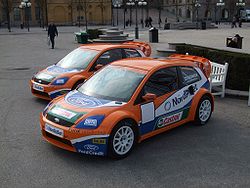
The 2008 Ford Fiesta ST ERC (4WD, 560 bhp (420 kW; 570 PS), 800 N·m (590 lb·ft)) of Marcus Grönholm for Rallycross pictured at a press conference in Stockholm.Manufacturer Ford's TeamRS and Swedish rally team MSE Fiesta ERC Div 1 is racecar with a 2.0 L Duratec turbocharged four cylinder engine, running on petrol or E85 (85% ethanol/15% petrol). It produces over 550 bhp (410 kW; 560 PS) and 820 N·m (600 lb·ft). That propels the 2,600 lb (1,200 kg) rally-prepped Fiesta up to sixty in 2.8 seconds. The car is driven by former champion Andreas Erikkson, double World Rally Champion Marcus Grönholm, X Games medalist Tanner Foust and several others. The cars are smaller and more powerful than WRC cars.
The Fiesta Rallycross cars made their U.S. debuts in July's Pikes Peak International Hill Climb in Colorado. Swedish Olsbergs Motor Sport Evolution (MSE) team announced the cars would later appear in ESPN's X Games 15 on 2009-08-02.[62] The Olsbergs MSE Fiesta Rallycross cars were based on the Fiesta hatchback model road cars, but with all-wheel drive, powered by 2.0 L Duratec Ford engines capable of more than 800 bhp (600 kW).
Circuit racing
In the UK, the Fiesta is commonly used in numerous club level motorsport series but has its national one-make series called the Ford Fiesta Championship. During its peak in the 1980s and 1990s, it had manufacturer support and it even was a support race to the British Grand Prix and numerous British Touring Car Championship rounds. The series has gone through numerous name changes including Ford Credit Fiesta Championship, Ford Fiesta Zetec Championship and BRSCC Ford Si Challenge and is nowadays run by the BRSCC (British Racing and Sports Car Club) as a club racing championship. The organisation also run the other series that consists of Fiestas.[63]
- Ford XR Challenge, for XR2 and XR2i models, also consists of the Escort XR models.[63]
- Ford Saloon Championship, mainly for a wider range of Ford models but Fiestas are mostly seen in classes C and E with a Mk 4 example winning the title outright in 2006 at the hands of Ollie Allen.[63][citation needed]
Popularity
In early 2009, total sales of the Fiesta since its launch 33 years earlier passed the 3,500,000 mark in Britain, making it the second most popular car ever sold there after the Ford Escort.[64] It has been Britain's most popular new car in 1990, 1991, 1996, 1997, 1998 and 2009.[65] In 2010, it was Britain's best selling car for the second year running.[66]
By the time of the MK2 Fiesta's demise in the spring of 1989, just under 1,300,000 had been sold in Britain since its launch 12 years earlier. By early 2007, well over 40,000 (more than 3%) were still in circulation,[67] though that figure has inevitably declined further since then.
Awards
- Winner of UK Design Council Efficiency Award for "exemplary contribution to the reduction of running and maintenance costs" in 1978. The award was presented by Prince Philip.
- Winner Australia's Best Small Car in 2004.
- Winner of Business Standard Motoring Jury Award, 2006.
- What Car's Best Used Supermini for 2006 – 1.4 Zetec 3dr 2003 – Runner Up Toyota Yaris 1.0 T2 3dr 2003.
- Winner of Brazilian Auto Esporte magazine Car of the Year in 2005 (Fiesta Sedan).
- Named Scottish Car of the Year 2008 at the 11th annual Association of Scottish Motoring Writers (ASMW) awards dinner in St Andrew's, Scotland.
- Named 'Car of the Year 1989' by Britain's What Car? magazine
- Named 'Car of the Year 2009' by Britain's What Car? magazine[45]
- Named 'Semperit Irish Small car of the Year' by tyre mafacturer Semperit
- Named 'Car of the Year' and 'Best Supermini' in Auto Express magazine's New Car Awards 2009
- Fiesta ECOnetic named 'Least boring green car'of 2009 by Top Gear's James May
- First minicar to achieve Top Safety Pick by the U.S. Insurance Institute for Highway Safety (IIHS) based on front-, side- and rear-impact crash testing and roof-strength.
- Winner of the 2011 AJAC Car of the year award for Best Small Car under $21,000.
See also
References
- ^ a b c d "Still going strong, Ford's youthful-spirited Fiesta is celebrating its 30th birthday". Media.Ford.com. 25 August 2006. http://media.ford.com/article_display.cfm?article_id=24102.
- ^ a b "STILL GOING STRONG, FORD'S YOUTHFUL-SPIRITED FIESTA IS CELEBRATING ITS 30TH BIRTHDAY" (PDF). http://media.ford.com/pdf/Fiesta_30th_EN.pdf. Retrieved 2010-08-26.
- ^ Retrospective: Ford Fiesta: 30th Anniversary[dead link]
- ^ "World wide comment: Fiesta in France". Autocar 144 (nbr 4155): 4–5. 26 June 1976.
- ^ "Hammond's trip down memory lane – Norfolk Motoring News, Road Tests and more". EDP24. http://www.edp24.co.uk/content/edp24/lifestyle/motoring/story.aspx?brand=EDPOnline&category=motoringNews&tBrand=EDPOnline&tCategory=motoringNews&itemid=NOED03%20Sep%202010%2010%3A26%3A32%3A877. Retrieved 2010-09-10.
- ^ a b "Ford Fiesta Global Heritage". Media.Ford.com. November 2009. http://media.ford.com/images/10031/Fiesta_Timeline.pdf. Retrieved 2010-01-02.
- ^ "Quantum 2+2". Quantum Sports Cars Ltd.. http://www.quantumcars.co.uk/showroom/2plus2/. Retrieved 2008-02-15.
- ^ a b c Still going strong, Ford's youthful-spired Fiesta is celebrating its 30th birthday Fordmedia.eu
- ^ "Facts & Figures: Ford Fiesta (99-02) 1.6 Zetec S 3d". Parkers.co.uk. Parkers. http://www.parkers.co.uk/cars/specs/Detail.aspx?deriv=18633. Retrieved 2011-03-18.
- ^ "Fiesta 2002". HonestJohn.co.uk. Honest John. http://www.honestjohn.co.uk/carbycar/ford/fiesta-2002/?section=good. Retrieved 2011-03-18.
- ^ http://www.ford.com.ar/ford2010/pdf/fiesta.pdf
- ^ "Ford Motor de Venezuela S.A. - Introducción Fiesta .move". Ford.com.ve. http://www.ford.com.ve/Carros. Retrieved 2010-08-26.
- ^ "Viva o Novo". Ford. http://www.ford.com.br/showroom.asp?veiculo=41. Retrieved 2010-08-26.
- ^ Ford Ikon Discontinued
- ^ Ford Fiesta India
- ^ a b c "Ford launches Fiest sedan in India". Wall Street Journal. http://online.wsj.com/article/SB10001424052702304911104576445281205342402.html. Retrieved 2011-07-14.
- ^ "Ford Fiesta ST". Parkers.co.uk. Parkers. http://www.parkers.co.uk/cars/specs/Detail.aspx?deriv=32683. Retrieved 2011-03-18.
- ^ "Ford Fiesta ST (preview)". Carenthusiast.com. http://www.carenthusiast.com/geneva2004.html?article=305. Retrieved 2010-08-26.
- ^ "Ford's New Fiesta Rally Car". Carkeys.co.uk. http://www.carkeys.co.uk/features/sport/1138.asp. Retrieved 2010-08-26.
- ^ Concept Car: Ford Fiesta RS[dead link]
- ^ "New car sales 2007: The results". motortrader.com. 2008-01-07. Archived from the original on 9 March 2008. http://web.archive.org/web/20080309101427/http%3A//www.motortrader.com/26406/New-car-sales-2007-The-results.ehtml. Retrieved 2008-02-15.
- ^ Nunez, Alex (9 February 2007). "Ford bites MINI's flavour with UK "chequered flag" model". Autoblog. http://www.autoblog.com/2007/02/09/ford-bites-minis-flavour-with-uk-chequered-flag-model/.
- ^ Driven: Ford Fiesta Zetec S 30th Anniversary[dead link]
- ^ Nunez, Alex (24 October 2007). "Ford unveils Fiesta Zetec S 'Celebration' in UK". Autoblog. http://www.autoblog.com/2007/10/24/ford-unveils-fiesta-zetec-s-celebration-in-uk/.
- ^ Joseph, Noah (26 June 2008). "Ford UK offers Red edition Fiesta Zetec S". Autoblog. http://www.autoblog.com/2008/06/26/ford-uk-offers-red-edition-fiesta-zetec-s/.
- ^ "2008 Ford Fiesta ST Mountune". Conceptcarz.com. 2008-03-01. http://www.conceptcarz.com/vehicle/z14860/Ford-Fiesta-ST-Mountune.aspx. Retrieved 2010-08-26.
- ^ "New sporty limited edition Fiesta ST". Automobilesreview.com. 2008-06-10. http://www.automobilesreview.com/auto-news/new-sporty-limited-edition-fiesta-st/2122/. Retrieved 2010-08-26.
- ^ "Geneva global debut for new Fiesta". Media.Ford.com. 15 February 2008. http://media.ford.com/article_display.cfm?article_id=27699.
- ^ ADAC motorwelt Heft 9 (September 2008) Seite 38. Muenchen.
- ^ "Fiesta 140ps Upgrade". Mountuneperformance.co.uk. http://www.mountuneperformance.co.uk/index.php?option=com_content&view=article&id=141&Itemid=58. Retrieved 2010-09-10.
- ^ "Ford Fiesta "global car" begins production". Canadian Driver. 2008-08-14. http://www.canadiandriver.com/2008/08/14/ford-fiesta-enters-volume-production.htm.
- ^ James Bergeron (2010-04-26). "First Drive: 2011 Ford Fiesta". Canadian Driver. http://www.canadiandriver.com/2010/04/26/first-drive-2011-ford-fiesta.htm.
- ^ "Introducing the 2011 Ford Fiesta". Ford Motor Company. http://www.fordvehicles.com/2011fiesta/.
- ^ "Ford rolls out global Fiesta at Rs 8.23 lakh". Times of India. http://timesofindia.indiatimes.com/business/india-business/Ford-rolls-out-global-Fiesta-at-Rs-823-lakh/articleshow/9229860.cms. Retrieved 2011-07-15.
- ^ a b Kiley, David (4 September 2008). "The 65 mpg Ford the U.S. Can't Have". BusinessWeek. http://www.businessweek.com/magazine/content/08_37/b4099060491065.htm. Retrieved 2009-05-09.
- ^ "Giving the Insight a Good Driver". AutoSpeed. http://autospeed.com/cms/title_Giving-the-Insight-a-Good-Driver/A_110187/article.html. Retrieved 2010-03-28.
- ^ "New fuel-miser Ford knocks Prius off its perch". Smh.com.au. 2009-10-16. http://www.smh.com.au/drive/motor-news/new-fuelmiser-ford-knocks-prius-off-its-perch-20091016-h0ck.html. Retrieved 2010-08-26.
- ^ "Ford Reveals Fiesta ST Concept at Frankfurt Motor Show; Previews Future High-Performance Fiesta" (Press release). Ford Motor Company Newsroom. 2011-09-13. http://media.ford.com/news/fordrevealsfiestastconceptatfrankfurtpreviewsfuturehighperformancefiesta.htm.
- ^ "Fuel, performance and emissions". Config.ford.co.uk. 2008-10-09. http://www.config.ford.co.uk/fordconnection/multimedia/gbr_en/00w/yyy/gbr_en00wyyyfuelspc.htm#. Retrieved 2010-08-26.
- ^ "Ford Fiesta Starts To Roll Off Rayong Plant This Month". paultan.org. http://paultan.org/2010/07/09/ford-fiesta-starts-to-roll-off-rayong-plant-this-month. Retrieved 2010-09-13.
- ^ "Ford Sales & Service (Thailand)". http://www.ford.co.th. Retrieved 2010-09-13.
- ^ Horrell, Paul (November 2008). "Small Minded". Motor Trend 60 (11): 44–50
- ^ "Ford Fiesta vs Vauxhall Corsa". Auto Express. August 2008. http://www.autoexpress.co.uk/carreviews/grouptests/226986/ford_fiesta_vs_vauxhall_corsa.html. Retrieved 2009-02-15.
- ^ "Ford Fiesta 1.6 (2008) CAR review | Road Testing Reviews | Car Magazine Online". Carmagazine.co.uk. 2008-08-27. http://www.carmagazine.co.uk/Drives/Search-Results/First-drives/Ford-Fiesta-2008-CAR-review/. Retrieved 2009-05-09.
- ^ a b "Fiesta named "Car of the Year" by What Car?, Britain's leading source of new car advice". Media.Ford.com. 22 January 2009. http://media.ford.com/article_display.cfm?article_id=29750. Retrieved 2009-05-09.
- ^ "Ford Fiesta Hatchback Full Review". What Car?. http://www.whatcar.com/car-reviews/ford/fiesta-hatchback/full-review/25846-5.
- ^ "Ford Remains Europe's No. 2 Best-Selling Car Brand in August and Year-to-Date". Ford Motor Company. 2010-09-16. http://www.at.ford.com/news/cn/Pages/FordRemainsEurope'sNo2Best-SellingCarBrandinAugustandYear-to-Date.aspx. Retrieved 2010-09-16.
- ^ a b Phil Patton (2010-09-10). "2 Cars Separated at Birth". The New York Times. http://www.nytimes.com/2010/09/12/automobiles/12DESIGN.html?hpw.
- ^ "Ford Forums, Ford News, Ford Motor Company News, Ford Employee Forum, Ford Reviews, Ford Edge Forum, Ford Flex Forum, Ford Fusion Forum, Ford Sales Figures, Ford Eco Boost Forum, Ford Transit Forum, Ford Transit Connect Forum, Lincoln MKS Forum – FORD'S NEW FIESTA TO DEBUT AT L.A. AUTO SHOW; FIESTA AGENTS BEGIN FINAL MONTH OF MISSIONS". BlueOvalNews. 2009-10-06. http://www.blueovalnews.com/index.php?categoryid=12&p2_articleid=760. Retrieved 2010-03-28.
- ^ "Car Wrap Designs for the Ford Fiesta". Ford Fiesta Graphics. http://www.fordfiestagraphics.com/faq.php. Retrieved 2010-03-28.
- ^ "Ford Fiesta 'Unwraps' Itself With Unique New Interactive Owner Delivery Experience | Ford Motor Company Newsroom". Media.ford.com. 2010-06-24. http://media.ford.com/article_display.cfm?article_id=32841. Retrieved 2010-08-26.
- ^ "Ford names 100 Fiesta Movement 'agents' to hit the road, find adventure, share experiences". Media.Ford.com. 7 April 2009. http://media.ford.com/wireless_article_display.cfm?article_id=30156. Retrieved 2009-06-06.
- ^ "Be part of Ford's Fiesta Movement: 100,000 test drives planned for the new fuel-efficient Fiesta". Media.Ford.com. 11 May 2009. http://media.ford.com/article_display.cfm?article_id=30344. Retrieved 2009-06-06.
- ^ "New Ford Fiesta to make cross-country tour". CanadianDriver. 29 July 2009. http://www.canadiandriver.com/2009/07/29/new-ford-fiesta-to-make-cross-country-tour.htm. Retrieved 2009-08-10.
- ^ Shunk, Chris (3 December 2009). "Ford accepting applications for Fiesta Movement 2". Autoblog. http://www.autoblog.com/2009/12/03/ford-accepting-applications-for-fiesta-movement-2/.
- ^ "Custom Ford Fiesta Designs from American Idol Finalists". Fast Fiesta. 18 March 2010. http://www.fastfiesta.com/idol-fiesta.html.
- ^ Jamie Lareau (2010-06-18). "Ford Fiesta not yet in dealerships; dealers and customers get antsy Read more: http://www.autoweek.com/article/20100618/CARNEWS/100619870#ixzz0xjouGWWd". Autonews via Autoweek. http://www.autoweek.com/article/20100618/CARNEWS/100619870.
- ^ Jeremy Korzeniewski (2010-07-13). "Ford Fiesta shipments delayed due to hurricane". Autoblog. http://www.autoblog.com/2010/07/13/ford-fiesta-shipments-delayed-due-to-hurricane-damaged-railroad/.
- ^ Chris Shunk (2010-08-26). "Ford Fiesta shipments flowing again after faulty part fixed". Autoblog. http://www.autoblog.com/2010/08/26/ford-fiesta-shipments-flowing-again-after-faulty-part-fixed/.
- ^ "Chevrolet Volt Electric Car is 2011 Green Car of the Year". Green Car Journal. 2010-11-18. http://www.greencar.com/articles/chevrolet-volt-electric-car-2011-green-car-year.php. Retrieved 2010-11-18.
- ^ "Jan–Apr 2011 Sales: Ford Motor Company – Cheers & Gears Forums". Cheersandgears.com. http://www.cheersandgears.com/topic/74946-december-2010-sales-ford-motor-company/. Retrieved 2011-01-04.
- ^ Joseph, Noah (2009-07-02). "Ford attacking X Games with star-studded trio of Fiesta rally cars". Autoblog.com. http://www.autoblog.com/2009/07/02/ford-attacking-x-games-with-star-studded-trio-of-fiesta-rally-ca/. Retrieved 2010-08-26.
- ^ a b c "BRSCC Ford Championships". http://www.fordracinguk.com/. Retrieved 2008-02-15.
- ^ "icLiverpool – Recession-proof wise-buys revealed". Icliverpool.icnetwork.co.uk. 2009-03-17. http://icliverpool.icnetwork.co.uk/motors/advice/tm_headline=recession-proof-wise-buys-revealed&method=full&objectid=23171460&siteid=63127-name_page.html. Retrieved 2010-03-28.
- ^ "Ford Fiesta is top in 09". Car Dealer Magazine. 2010-01-08. http://www.cardealermagazine.co.uk/publish/ford-fiesta-is-2009-best-seller/28370. Retrieved 2010-03-28.
- ^ [1]
- ^ The Independent (London). 2007-04-10. http://www.independent.co.uk/life-style/motoring/features/nissan-micra-443911.html.
External links
- Ford Fiesta USA official website
- Ford Fiesta UK official website
- Ford UK Fiesta van site
- Ford Fiesta official history website (Mark and time line history) Ford of Europe, Media Kits
- Ford Fiesta Graphics (official US accessory)
- USA Ford Fiesta Fan Site
- known Problem "EAC-Fail" at 1,25 / 1,4 / 1,6 Duratec Engine
Recent, current, and future vehicles, North American market from Ford Motor Company Passenger cars Crossover vehicles Sport Utility Vehicles Trucks/Vans Recently discontinued models
(2000s-present)Ford of Europe Divisions and
subsidiariesCurrentDefunctFacilities CurrentAutomobile Craiova · Bridgend Engine · Cologne Body & Assembly · Dagenham Plant · Dunton Technical Centre · Genk Body & Assembly · Lommel Proving Grounds · Merkenich Technical Centre · Otosan Assembly · Saarlouis Body & Assembly · Southampton Body & Assembly · Valencia Plant · Vsevolozhsk AssemblyFormerPassenger cars CurrentPastCommercial vehicles MinibusesTrucks (defunct)VansCurrentPastFord car timeline, North American market, 1946–1979 — next » Type 1940s 1950s 1960s 1970s 6 7 8 9 0 1 2 3 4 5 6 7 8 9 0 1 2 3 4 5 6 7 8 9 0 1 2 3 4 5 6 7 8 9 Subcompact Pinto Fiesta Compact Falcon Falcon Falcon Maverick Fairmont Granada Mid-size Falcon 70½ Fairlane Fairlane Fairlane Fairlane Torino Torino Torino LTD II Full-size Deluxe Ford Deluxe Mainline Super Deluxe Custom Customline Custom 300 Custom Custom Custom Custom Crestline Fairlane Fairlane Fairlane Galaxie Galaxie Galaxie Galaxie Galaxie LTD LTD LTD LTD Personal luxury Thunderbird Thunderbird Thunderbird Thunderbird Thunderbird Thunderbird Thunderbird Sports Thunderbird Mustang Mustang II Mustang Type 1980s 1990s 2000s 2010s 0 1 2 3 4 5 6 7 8 9 0 1 2 3 4 5 6 7 8 9 0 1 2 3 4 5 6 7 8 9 0 1 2 Subcompact Fiesta Festiva Aspire Fiesta Compact Pinto Escort Escort Escort Focus Focus Focus Fairmont Tempo Tempo Contour Mid-size Granada LTD Fusion Taurus Taurus Taurus Taurus Full-size LTD LTD Crown Victoria Crown Victoria Crown Victoria Country Squire Five Hundred Taurus Taurus Personal luxury Thunderbird Thunderbird Thunderbird Thunderbird Sport compact EXP EXP Probe Probe Escort ZX2 ZX2 Sports Mustang Mustang Mustang GT Ford car timeline, European market, 1960s–1980s — next » Type 1960s 1970s 1980s 0 1 2 3 4 5 6 7 8 9 0 1 2 3 4 5 6 7 8 9 0 1 2 3 4 5 Supermini Fiesta I Fiesta II Small family car Anglia 105E / Super Anglia 123E Escort I Escort II Escort III Large family car Consul II Cortina I Cortina II Cortina III / Taunus TC Cortina IV / Taunus III Cortina V / Taunus III Sierra Taunus G13 Taunus P4 Taunus P6 Classic Corsair Executive car Taunus P3 Taunus P5 Taunus P7 Taunus P7.2 Consul (Granada) Granada I Granada II Zephyr II Zephyr 4/6 III Zephyr 4/6 IV Zodiac II Zodiac III Zodiac IV Coupé Consul Capri Capri Mk1 Capri Mk2 Capri Mk3 « previous — Ford car timeline, European market, 1980s–present Type 1980s 1990s 2000s 2010s 0 1 2 3 4 5 6 7 8 9 0 1 2 3 4 5 6 7 8 9 0 1 2 3 4 5 6 7 8 9 0 1 2 City car Ka I Ka II Supermini Fiesta I Fiesta II Fiesta III Fiesta IV Fiesta V Fiesta VI Small family car Escort Mk3 / Orion I Escort Mk4 / Orion II Escort Mk5 / Orion III Escort Mk5b Escort Mk6 Focus I Focus II Focus III Large family car Cortina V / Taunus III Sierra I Sierra II Mondeo I Mondeo II Mondeo III Mondeo IV Executive car Granada II Scorpio I / Granada III Scorpio II Coupé Capri Puma Probe Cougar Compact SUV Maverick CUV Maverick Kuga Fusion Mini MPV B-MAX Compact MPV C-MAX I C-MAX II Large MPV S-MAX Galaxy I Galaxy II Galaxy III Ford Motor Company of Australia automobile timeline, 1980s–present Type 1980s 1990s 2000s 2010s 0 1 2 3 4 5 6 7 8 9 0 1 2 3 4 5 6 7 8 9 0 1 2 3 4 5 6 7 8 9 0 1 2 City Ka Subcompact Festiva Festiva Fiesta Fiesta Compact Escort Laser Laser Laser Laser Laser Focus Focus Focus Meteor Mid-size Cortina Telstar Telstar Taurus Corsair Mondeo Mondeo Full-size Falcon / Fairmont Falcon / Fairmont Falcon / Fairmont Falcon / G Series Fairlane / LTD Fairlane / LTD Fairlane / LTD Sports Capri Probe Cougar Mustang Utility Courier Courier Ranger Ranger Falcon Ute Falcon Ute Falcon Ute Van Falcon Van Spectron Econovan Econovan Econovan Transit Transit Transit Transit Compact SUV Escape Escape Mid-size SUV Raider Territory Bronco Maverick Explorer Explorer Categories:- Vehicles introduced in 1976
- Vehicles introduced in 2008
- Ford of Europe vehicles
- Subcompact cars
- Hatchbacks
- Sedans
- Euro NCAP superminis
- Hot Hatch
- Sports sedans
- Ford B3 platform
- Rally cars
- Cars of Spain
- Vehicles with CVT transmission
- Front wheel drive vehicles
- Goods manufactured in Germany
- 1970s automobiles
- 1980s automobiles
- 1990s automobiles
- 2000s automobiles
- 2010s automobiles
Wikimedia Foundation. 2010.



